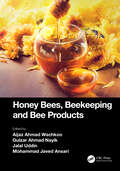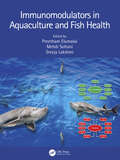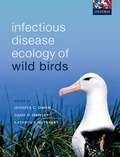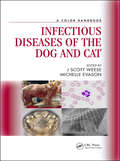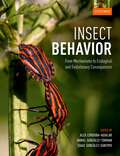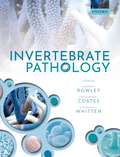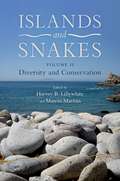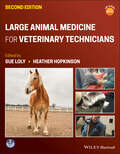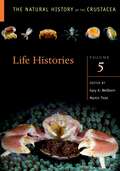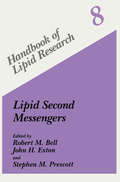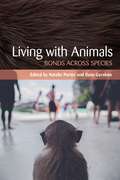- Table View
- List View
Honey Bees, Beekeeping and Bee Products
Honey bees are social insects; they live together in large, well-organized family groups comprising three castes: queen (fertile female), workers (sterile females) and drones (males). During honey flow season, there is a considerable increase in the foraging activity of the workers and in the rate of egg laying by the queen. Sex determination in honey bees involves a multi-allelic locus, such that homozygotes develop as males and heterozygotes as females, whereas diet quality influences the caste determination in honey bees. Like all living organisms, honey bees can be infested with diseases and pests. Some of these are more deleterious to bee colonies than others, but it is important for the beekeeper to be able to recognize conditions that might be disease or pest-related and respond accordingly so as to improve the quality of honey and honey bee by-products.The best-known primary products of beekeeping are honey and wax, but pollen, propolis, royal jelly, venom, queens, bees and their larvae are also marketable primary bee products. The purpose of this book is to make available information on bee biology and beekeeping as well as to provide comprehensive information on manufacturing, processing and marketing of value-added bee products.This book has been designed as a useful tool for the many diverse professionals who characterize and market honey bee products, including beekeepers, non-beekeepers, small entrepreneurs, extension officers and those involved in small business development. This edited book will be the first of its kind to contain comprehensive information on both bees and bee products.Key Features: Contains comprehensive information on beekeeping. Discusses the recent advances in beekeeping. Sheds light on bee colony integration and organization. Contains brief information on honey bee products.
Horse (Large Print)
In this image, the horse is shown from the side with its head on the left of the page and tail on the right. There is a locator dot shown, which will be at the top left of the page when the image is the right way up. This horse is looking towards you, so both ears, eyes and nostrils can be found. The horse has a long neck with a hairy mane along the top. It has a large, brown body and stands on four long legs each with a hoof at the end. On the right side of the page is the horse's long tail.
Horse (UEB Contracted)
In this image, the horse is shown from the side with its head on the left of the page and tail on the right. There is a locator dot shown, which will be at the top left of the page when the image is the right way up. This horse is looking towards you, so both ears, eyes and nostrils can be found. The horse has a long neck with a hairy mane along the top. It has a large, brown body and stands on four long legs each with a hoof at the end. On the right side of the page is the horse's long tail.
Horse (UEB Uncontracted)
In this image, the horse is shown from the side with its head on the left of the page and tail on the right. There is a locator dot shown, which will be at the top left of the page when the image is the right way up. This horse is looking towards you, so both ears, eyes and nostrils can be found. The horse has a long neck with a hairy mane along the top. It has a large, brown body and stands on four long legs each with a hoof at the end. On the right side of the page is the horse's long tail.
Immunomodulators in Aquaculture and Fish Health
This reference book provides updated information about different immunomodulators for managing fish health and sustainable aquaculture. Immunomodulators are dietary additives that enhance innate defense mechanisms and increase resistance against specific pathogens and diseases. The book covers the different types of immunostimulants, their modes of action, and their efficacies. It also reviews safety concerns, ethical regulations, limitations, and outreach to farmers. It discusses the application of herbal immunomodulators, antioxidants, pre- and pro-biotics, in disease management. Features:• Reviews the pressing topic of reduction of antibiotic use in aquaculture • Discusses herbal immunomodulators, nutrients, antioxidants and pre- and pro-biotics • Covers the topic of progressive immunomodulation using nanotechnology • Discusses fish health management in the ever-growing aquaculture industry • Includes natural and synthetic immunomodulators The book is meant for researchers and industry experts in aquaculture, fisheries science, and veterinary medicine.
Infectious Disease Ecology of Wild Birds
Birds are the most diverse group of land vertebrates and have evolved to exploit almost every terrestrial niche on earth. They also serve as a natural reservoir for an array of different pathogens that pose serious health risks to human and domestic animal populations, including West Nile virus, highly pathogenic avian influenza viruses, Newcastle Disease virus, and numerous enteric pathogens. Avian diseases are also critically important to the conservation of endemic bird species in many places around the world. This accessible textbook focuses on the dynamics of infectious diseases for wild avian hosts across every level of ecological hierarchy, from the way pathogens interact with the physiology and behavior of individual hosts, the evolutionary and ecological dynamics of the host-parasite interactions occurring within populations, up to the complex biotic and abiotic interactions occurring within biological communities and ecosystems. Parasite-bird interactions are also increasingly occurring in rapidly changing global environments - thus, their ecology is also changing - and this shapes the complex ways by which parasites influence the inter-connected health of birds, humans, and shared ecosystems. Given the key role of birds in ecological communities more broadly, and as the primary host to so many zoonotic pathogens, an understanding of the ecological and evolutionary principles underlying the maintenance, amplification, transmission, and dispersal of these infectious agents is crucial to understanding how to mitigate the negative global impacts of the ever-increasing number of emerging infectious diseases. Although the topics and principles discussed in this book relate to birds, they have a far wider relevance and can also be applied to non-avian, wildlife host-pathogen systems. The COVID-19 pandemic has shown that understanding of disease ecology in wild animal populations is paramount to global health. Infectious Disease Ecology of Wild Birds is suitable for both senior undergraduate and graduate students taking courses in avian disease ecology, ecoimmunology, ecology, and conservation. It will also appeal to the many professional parasitologists, ecoimmunologists, ornithologists, behavioural ecologists, conservation biologists, and wildlife biologists requiring a concise overview of the topic.
Infectious Diseases of the Dog and Cat: A Color Handbook
This is a concise and quick reference guide, clinically oriented, based on experience underpinned by published research data. The systems-based approach emphasizes the problem list process utilized by most practitioners when faced with a patient presenting with a single or variety of clinical symptoms. This allows generation of a complete list of infectious disease differentials, and the ability to include or exclude those indicated based on patient risk assessment. Pathogen specific information enables rational choice of diagnostics, therapy, and prognostication for a complete list of small animal infectious disease that includes bacterial, viral, parasitic/protozoal and fungal.
Infectious Diseases of the Dog and Cat: A Color Handbook
This is a concise and quick reference guide, clinically oriented, based on experience underpinned by published research data. The systems-based approach emphasizes the problem list process utilized by most practitioners when faced with a patient presenting with a single or variety of clinical symptoms. This allows generation of a complete list of infectious disease differentials, and the ability to include or exclude those indicated based on patient risk assessment. Pathogen specific information enables rational choice of diagnostics, therapy, and prognostication for a complete list of small animal infectious disease that includes bacterial, viral, parasitic/protozoal and fungal.
Insect Behavior: From Mechanisms to Ecological and Evolutionary Consequences
Insects display a staggering diversity of behaviors. Studying these systems provides insights into a wide range of ecological, evolutionary, and behavioral questions including the genetics of behavior, phenotypic plasticity, chemical communication, and the evolution of life-history traits. This accessible text offers a new approach that provides the reader with the necessary theoretical and conceptual foundations, at different hierarchical levels, to understand insect behavior. The book is divided into three main sections: mechanisms, ecological and evolutionary consequences, and applied issues. The final section places the preceding chapters within a framework of current threats to human survival - climate change, disease, and food security - before providing suggestions and insights as to how we can utilize an understanding of insect behavior to control and/or ameliorate them. Each chapter provides a concise, authoritative review of the conceptual, theoretical, and methodological foundations of each topic.
Invertebrate Pathology
Many invertebrates are serious pests of agriculture (e.g., mites and locusts), vectors of disease (e.g., mosquitoes and aquatic snails) and venomous (e.g., scorpions), whilst others are beneficial to humans as pollinators, food sources, and detritivores. Despite their obvious ecological, medical, and economic importance, this is the first comprehensive review of invertebrate diseases to be available within a single volume. Concurrent molecular and bioinformatics developments over the last decade have catalysed a renaissance in invertebrate pathology. High-throughput sequencing, handheld diagnostic kits, and the move to new technologies have rapidly increased our understanding of invertebrate diseases, generating a large volume of fundamental and applied research on the topic. An overview is now timely and this authoritative work assembles an international team of the leading specialists in the field to review the main diseases and pathologic manifestations of all the major invertebrate groups. Each chapter adopts a common plan in terms of its scope and approach to achieve a succinct and coherent synthesis. Invertebrate Pathology is aimed at graduate students and researchers in the fields of disease ecology, invertebrate biology, comparative immunology, aquaculture, fisheries, veterinary science, evolution, and conservation. It will be particularly useful for readers new to the field as well as a broader interdisciplinary audience of practitioners and resource managers.
Islands and Snakes: Diversity and Conservation
In this follow-up to Islands and Snakes, this book contains 15 chapters describing diversity and conservation of snakes on islands, with foci on selected island systems not previously summarized. Attendant topics include biogeography, plasticity and evolutionary responses to insular conditions, invasive species, importance and collapse of trophic systems, threats to insular snake populations, and strategies of conservation to save them. Chapters include descriptions of snake faunas on larger islands such as Borneo and New Guinea; reproductive biology of insular snakes; phenotypic evolution; physiology and growth patterns related to diet and environment; patterns of endemism; taxonomy of snake radiations; and history of invasions by snakes on islands. The final chapter presents a discussion of prospects and overview of conservation of snakes on islands. Chapters are contributed by international authorities on respective island-and-snake systems. The latter include some islands or archipelagos that are young, or of high importance, or support snake populations that were previously not well known. The content includes colourful photographs, informative illustrations, and in some cases synthesis of new data relevant to the importance of islands for understanding the ecological underpinnings and genesis of biodiversity. Each chapter is appropriately referenced with citations to scientific literature, and where useful, footnotes, tables and graphic information supporting the narrative of the respective subject matter. The overall presentation is intended to provide readers with an enhanced appreciation for islands and the spectacular snakes that might live there.
Japan's Withdrawal from International Whaling Regulation
This book examines the impact and implications of Japan's withdrawal from the International Convention for the Regulation of Whaling (ICRW), which came into effect in July 2019. In 1982 the International Whaling Commission (IWC) adopted a moratorium on commercial whaling which has been in effect ever since, despite the resistance of some countries, first and foremost Japan, Norway and Iceland, that engage in commercial whaling. As one of the key contributors to scientific research and funding, Japan's withdrawal has the potential to have wide-ranging implications and this volume examines the impact of Japan's withdrawal on the IWC itself, on the governance of whaling, and on indigenous and coastal whaling. It provides backgrounds and commentaries on this decision as well as normative and legal discussions on matters relating to sustainable use of resources, and philosophies surrounding whaling in different IWC countries. The consideration of other international environmental regimes, such as the Convention on International Trade in Endangered Species (CITES) are also examined in order to determine the international ripple effect of Japan’s decision. The book reveals that this is not just a matter of whaling but one which has significant legal, managerial and cultural implications. Drawing on deep analyses of IWC structures, the book addresses core philosophies underlying the whaling debate and in how far these may influence environmental governance in the future. This book will be of great interest to students and scholars of environmental law and governance, biodiversity conservation and sustainable development, as well as policymakers involved in international environmental and conservation agreements.
Kangaroo (Large Print)
This kangaroo is shown from the side, with its head at the top right and tail at the bottom left of the page. There is a locator dot shown, which will be at the top left of the page when the image is the right way up. Its head is turned to face you. There are two big ears on top of its head, small eyes in the middle and its nostrils at the bottom. Down from the kangaroo's head is its chest which leads to small forelimbs. To the left of its forelimbs is a pouch sticking out, where a baby kangaroo or joey would sit. Beside its pouch are the kangaroo's huge legs and feet with toes at the end. To the left of its legs is its big long tail.
Kangaroo (UEB contracted)
This kangaroo is shown from the side, with its head at the top right and tail at the bottom left of the page. There is a locator dot shown, which will be at the top left of the page when the image is the right way up. Its head is turned to face you. There are two big ears on top of its head, small eyes in the middle and its nostrils at the bottom. Down from the kangaroo's head is its chest which leads to small forelimbs. To the left of its forelimbs is a pouch sticking out, where a baby kangaroo or joey would sit. Beside its pouch are the kangaroo's huge legs and feet with toes at the end. To the left of its legs is its big long tail.
Kangaroo (UEB uncontracted)
This kangaroo is shown from the side, with its head at the top right and tail at the bottom left of the page. There is a locator dot shown, which will be at the top left of the page when the image is the right way up. Its head is turned to face you. There are two big ears on top of its head, small eyes in the middle and its nostrils at the bottom. Down from the kangaroo's head is its chest which leads to small forelimbs. To the left of its forelimbs is a pouch sticking out, where a baby kangaroo or joey would sit. Beside its pouch are the kangaroo's huge legs and feet with toes at the end. To the left of its legs is its big long tail.
Kingfisher (Large Print)
This is an image of a kingfisher with its head towards the top centre left of the page and its tail in the bottom right. There is a locator dot shown, which will be at the top left of the page when the image is the right way up. It has a very long, thick, pointed beak which is slightly open and has an orange patch along the base. Its eye is to the right, and there is an orange patch and a white patch down from this. In the centre of the page is the kingfisher's upright body with an orange patch on its chest and a shiny blue folded wing. The long tail is at the lower right of the page. To the left of the tail are the kingfisher's two short legs and small feet.
Kingfisher (UEB Contracted)
This is an image of a kingfisher with its head towards the top centre left of the page and its tail in the bottom right. There is a locator dot shown, which will be at the top left of the page when the image is the right way up. It has a very long, thick, pointed beak which is slightly open and has an orange patch along the base. Its eye is to the right, and there is an orange patch and a white patch down from this. In the centre of the page is the kingfisher's upright body with an orange patch on its chest and a shiny blue folded wing. The long tail is at the lower right of the page. To the left of the tail are the kingfisher's two short legs and small feet.
Kingfisher (UEB Uncontracted)
This is an image of a kingfisher with its head towards the top centre left of the page and its tail in the bottom right. There is a locator dot shown, which will be at the top left of the page when the image is the right way up. It has a very long, thick, pointed beak which is slightly open and has an orange patch along the base. Its eye is to the right, and there is an orange patch and a white patch down from this. In the centre of the page is the kingfisher's upright body with an orange patch on its chest and a shiny blue folded wing. The long tail is at the lower right of the page. To the left of the tail are the kingfisher's two short legs and small feet.
Large Animal Medicine for Veterinary Technicians
Large Animal Medicine for Veterinary Technicians provides comprehensive guidance on caring for horses, cattle, camelids, small ruminants, pigs, and other farm animals. Reflecting the topics required by the American Veterinary Medical Association (AMVA), this practical resource covers hospital biosecurity, restraint, physical examinations, clinical and diagnostic procedures, reproduction, nutrition, disease, and more. Detailed chapters written by expert contributors contain numerous full-color images, clinical applications, self-review questions, and accurate, species-specific information. The second edition features revised and new content throughout, including brand-new chapters on common surgical procedures and general anesthesia, dentistry, and popular hobby farm animals such as fowl, poultry, and pet pigs. Updated and expanded sections on neonatology, diagnostics, and imaging are supported by a wealth of new images and examples. Covering the skills and knowledge necessary for success in both Veterinary Technician Specialty (VTS) programs and in clinical practice, this must-have guide: Offers new coverage of imaging and diagnostic technologies such as dynamic endoscoping and the use of treadmills Contains more than 500 high-quality color images, multiple-choice questions with answers, and a glossary of terms Features a range of pedagogical tools including learning objectives, clinical case problems, charts and diagrams, and “Technician Tip” boxes Includes a significantly expanded companion website with self-review questions, case studies, PowerPoint slides, and an image bank to aid in breed identification Authored and edited by experienced trainers and certified veterinary technicians, Large Animal Medicine for Veterinary Technicians, Second Edition an invaluable reference for all students, educators, and working professionals in the field.
Life Histories: Volume 5 (The Natural History of the Crustacea)
Crustaceans are increasingly being used as model organisms in all fields of biology, including neurobiology, developmental biology, animal physiology, evolutionary ecology, biogeography, and resource management. Crustaceans have a very wide range of phenotypes and inhabit a diverse array of environments, ranging from the deep sea to high mountain lakes and even deserts. The evolution of their life histories has permitted crustaceans to successfully colonize this variety of habitats. Few other taxa exhibit such a variety of life histories and behavior. A comprehensive overview of their life histories is essential to the understanding of many aspects of their success in marine and terrestrial environments. This volume provides a general overview of crustacean life histories. Crustaceans have particular life history adaptations that have permitted them to conquer all environments on earth. Crustacean life cycles have evolved to maximize fecundity, growth, and ageing, in a wide range of environmental conditions. Individual contributions contrast benefits and costs of different life histories including sexual versus asexual production, semelparity versus iteroparity, and planktonic larvae versus direct development. Important aspects of particular behaviors are presented (e.g. migrations, defense and territorial behaviors, anti-predator behavior, symbiosis).
Lipid Second Messengers (Handbook of Lipid Research #8)
Lipids traditionally have been viewed as serving two functions: to form cellular membranes and to serve as energy stores. During the last two decades, a new role for lipids has taken center stage: lipids can act as signalling molecules. This book deals with a variety of lipids that have been shown to be messengers. Leading scientists explore all known lipid classes except steroid hormones. Researchers and educators in biochemistry as well as in molecular and cellular biology will appreciate this volume.
Living with Animals: Bonds across Species
Living with Animals is a collection of imagined animal guides—a playful and accessible look at different human-animal relationships around the world. Anthropologists and their co-authors have written accounts of how humans and animals interact in labs, in farms, in zoos, and in African forests, among other places. Modeled after the classic A World of Babies, an edited collection of imagined Dr. Spock manuals from around the world—With Animals focuses on human-animal relationships in their myriad forms.This is ethnographic fiction for those curious about how animals are used for a variety of different tasks around the world. To be sure, animal guides are not a universal genre, so Living with Animals offers an imaginative solution, doing justice to the ways details about animals are conveyed in culturally specific ways by adopting a range of voices and perspectives. How we capitalize on animals, how we live with them, and how humans attempt to control the untamable nature around them are all considered by the authors of this wild read.If you have ever experienced a moment of "what if" curiosity—what is it like to be a gorilla in a zoo, to work in a pig factory farm, to breed cows and horses, this book is for you. A light-handed and light-hearted approach to a fascinating and nuanced subject, Living with Animals suggests many ways in which we can and do coexist with our non-human partners on Earth.
Lop eared rabbit (Large Print)
This is an image of a lop eared rabbit seen from the side with its head facing you. There is a locator dot shown, which will be at the top left of the page when the image is the right way up. The light brown rabbit's head is in the top centre of the page with two eyes, nose and mouth. It has floppy ears sticking out to the left and right. The rabbit's body is down and right. Two of its legs can be found further down the page, and its fluffy, light-coloured tail is to the right of its body.
Lop eared rabbit (UEB Contracted)
This is an image of a lop eared rabbit seen from the side with its head facing you. There is a locator dot shown, which will be at the top left of the page when the image is the right way up. The light brown rabbit's head is in the top centre of the page with two eyes, nose and mouth. It has floppy ears sticking out to the left and right. The rabbit's body is down and right. Two of its legs can be found further down the page, and its fluffy, light-coloured tail is to the right of its body.
Lop eared rabbit (UEB Uncontracted)
This is an image of a lop eared rabbit seen from the side with its head facing you. There is a locator dot shown, which will be at the top left of the page when the image is the right way up. The light brown rabbit's head is in the top centre of the page with two eyes, nose and mouth. It has floppy ears sticking out to the left and right. The rabbit's body is down and right. Two of its legs can be found further down the page, and its fluffy, light-coloured tail is to the right of its body.
